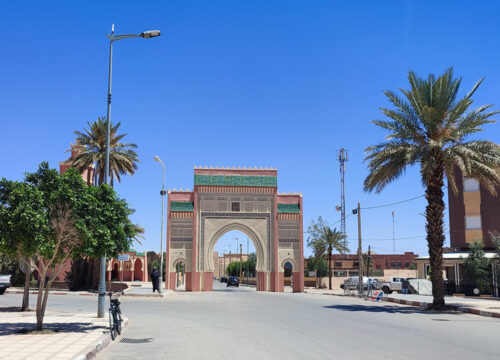Morocco is a beautiful country with captivating landscapes and architecture, a rich culture, and an impressive history, but Moroccan cuisine is a source of national pride.
Who doesn’t love classic Moroccan dishes such as couscous, tagine, pastilla, and mint tea? We certainly do at Moorish Trips.
Moorish Trips is where you’ll find a full menu of traditional Moroccan cuisine that honors the centuries-old legacies of its food and culture.
But, just what dishes are considered to be Moroccan food classics?
Our team will cover 10 of the most popular traditional Moroccan dishes in this blog.
People Also Ask: What is a traditional Moroccan food?
Moroccan cuisine dishes are diverse and flavorful. They encompass a wide array of ingredients ranging from vegetables and legumes to fruits, nuts, spices, and meats.
What is a typical Moroccan dinner?
Typically, Moroccan dinner dishes include a variety of tagines, couscous, soups, and grilled meats. With a Moroccan-inspired dinner menu, you’ll find dishes like pastilla, harira, kefta, and desserts such as baklava and mint tea.
1- Tajine
When most people think of Moroccan food, they think of tajine. Said to have originated in the ancient cooking traditions of Morocco, tajine has become emblematic of Moroccan cuisine across the country’s diverse regions, benefiting from the local produce and spices.
Moroccan tajine is distinguished by its unique preparation and slow-cooking method, utilizing:
- A variety of meats (such as chicken, lamb, or beef)
- Vegetables
- Fruits (like apricots, plums, and raisins)
- Spices (including cumin, coriander, saffron, and ginger)
A highly versatile dish, it can be served with countless combinations of ingredients.
2- Couscous
Couscous, alongside tajine, stands as one of Morocco’s most celebrated dishes. Recognized globally, it symbolizes Moroccan culture, earning UNESCO’s designation as an Intangible Cultural Heritage of Humanity. Unique preparation secrets, held by Moroccan families and chefs, underscore its significance and variety.
However, couscous is typically made of:
- Semolina (Wheat)
- Water
- Salt
It is said that couscous was developed by the Berber people of North Africa centuries ago and has become a staple in Moroccan cuisine.
Perhaps the most celebrated type of couscous is served with a stew of meat (such as lamb or chicken), vegetables (like carrots, zucchini, and chickpeas), and sometimes dried fruits, topped with a rich broth.
3- Fich Charmoula
Surrounded by both the Atlantic Ocean and the Mediterranean Sea, with a long coastline and rich fishing traditions, seafood is a common staple in the Moroccan diet and the main ingredient in many dishes. When it comes to Moroccan cuisine, you’ll find a variety of fresh seafood paired with herbs, spices, vegetables, and sometimes couscous or bread.
Some examples of popular Moroccan seafood include:
- Sardines
- Mackerel
- Shrimp
- Squid
- Sea Bream
In Morocco, fish charmoula is a celebrated way to prepare seafood. Charmoula is a marinade and relish used in Moroccan cooking that typically includes herbs, spices, lemon, and garlic, which infuses the fish with rich flavors. Moroccan-American cuisine has embraced this tradition, offering dishes like grilled sardines, baked sea bream with charmoula, and shrimp tagine.
4- Harira
Another pillar of Moroccan cuisine is Harira. This dish is a rich soup that combines a variety of ingredients to create a hearty and flavorful meal. Harira typically includes tomatoes as a base and is rich with lentils, chickpeas, and finely chopped herbs such as cilantro and parsley.
The most popular ingredients in Harira often include:
- Lamb (though beef or chicken can also be used)
- Lentils
- Chickpeas
In addition to these, Harira is seasoned with a blend of spices, including ginger, turmeric, and cinnamon, and sometimes rice or fine noodles are added to thicken the soup. It’s a staple dish especially during the month of Ramadan, breaking the fast at sunset, but it is also enjoyed year-round as a comforting and nutritious meal.
5- Bastilla
The variety of filled pastries celebrated in Morocco is vast. From the north to the south of Morocco, almost every region has its own version of Bastilla (also spelled Pastilla).
Bastilla is a pie made from thin, crispy layers of dough (warqa) and then filled with a savory mixture. The filled, enveloped pastry is often dusted with powdered sugar and cinnamon, creating a unique blend of sweet and savory flavors. Bastilla shapes are traditionally large and round, designed to be shared.
- Common Bastilla fillings can include:
- Poultry (traditionally pigeon, but chicken is more commonly used now)
- Eggs (scrambled and mixed with the meat)
- Almonds (fried and ground, often mixed with cinnamon and sugar)
- Herbs and Spices (like coriander, parsley, and saffron)
Seafood Bastilla is also popular, incorporating a mixture of fish and seafood for a coastal twist on the traditional recipe.
6- Khoubz
Traditional khobz — Moroccan bread baked in a clay or wood-fired oven — is typically made from a simple dough of flour, water, yeast, and salt, then shaped into round, flat loaves. To add a unique touch, we infuse the dough with local flavors like olive oil and sometimes herbs or seeds for an aromatic twist.
For convenience and to cater to home baking, our version can be made in a standard oven and, while keeping to the essence of traditional khobz, we suggest adding a blend of sesame and nigella seeds to the dough.
7- Steamed Sheep Head
These traditional, preparation-intensive Moroccan steamed sheep heads (a dish known simply as “smen”) originated as a means of celebrating special occasions and utilizing every part of the sheep, in keeping with principles of respect and zero waste. In this version inspired by the culinary practices observed during the festival of Eid al-Adha, the sheep head is carefully cleaned, seasoned with a blend of herbs and spices such as cumin, salt, and pepper, and then slowly steamed to perfection.
The steaming process tenderizes the meat, allowing it to fall off the bone, and infuses it with the aromatic spices, creating a dish that is deeply flavorful and revered across Morocco.
8- Spicy Sardines
Spicy Sardines is a classic dish from the coastal regions of Morocco. It’s said to have origins deeply rooted in Moroccan fishing traditions, where fresh sardines, abundant in the Atlantic and Mediterranean waters surrounding Morocco, are marinated in a fiery blend of chermoula—a mixture of herbs, garlic, lemon, and spices including cumin, paprika, and sometimes a touch of chili for heat.
The marinated sardines are then grilled or baked, allowing the bold flavors of the chermoula to penetrate the fish, creating a dish that is both spicy and deeply aromatic.
9- Mint Tea
Mint Tea is a Moroccan-style beverage, a staple at Moroccan gatherings and a symbol of hospitality. It is also called “Moroccan whiskey” due to its popularity and significance in Moroccan culture. For this comforting version, steep green tea with fresh mint leaves and sweeten with sugar to taste.
The preparation involves boiling water, then adding loose green tea leaves to the pot, followed by a generous handful of fresh mint. The tea is often sweetened considerably, making it both refreshing and a delightful end to meals or a welcoming gesture to guests.
10- Bissara
Preparing something in the style of Bissara means cooking dried fava beans or split peas until they’re soft and then puréeing them into a thick, creamy soup or dip. In this traditional Moroccan recipe, fava beans are the primary ingredient, but it can also be made with split peas, depending on regional preferences or availability.
The beans or peas are soaked overnight, then simmered with garlic, olive oil, and spices such as cumin and paprika, until everything is tender and flavorful. The mixture is then blended into a smooth consistency, served either as a warming soup or as a thick dip, often drizzled with olive oil and accompanied by a sprinkle of cumin or chili powder on top for added flavor.
11- Crumbed Liver
Crumbed Liver, a classic Moroccan dish known for its rich flavors and simple preparation, draws inspiration from the traditional methods of cooking liver in Morocco. To make it, slices of liver are first marinated in a mixture of garlic, spices such as cumin, paprika, and sometimes a bit of harissa for heat, then dredged in flour or fine breadcrumbs.
The marinated and coated liver slices are then fried until the outside is crispy and golden, while the inside remains tender and flavorful.
12- Brochette
The most essential main dish of classical Moroccan cuisine. The brochette, often made with marinated pieces of lamb, beef, or chicken, is seasoned with a blend of spices including cumin, paprika, and a hint of garlic, then threaded onto skewers.
The marinated meat is then grilled to perfection, ensuring each piece is juicy and infused with the rich, aromatic flavors of Moroccan spices.
13- Snail Soup
Snail Soup is a broth-based dish that emerged from the rich culinary traditions of Morocco, particularly favored in street markets and by adventurous eaters. This unique soup was crafted by Moroccan vendors and cooks who sought to utilize locally sourced snails, turning them into a delicacy enjoyed by both locals and visitors alike.
The Moroccan version includes a range of carefully selected spices like ginger, fennel, anise, and peppermint, creating a broth that is both aromatic and deeply flavorful. Snails are meticulously cleaned and then simmered in this spiced broth, making the soup a comforting and reputedly healthful treat.
14- Zalouk
Zalouk is a well-known Moroccan dish that hails from the diverse culinary regions of Morocco and can be prepared in various ways. It is often rich and flavorful, marked by its smoky taste, and is prepared with eggplants and tomatoes simmered in spices.
15- Makouda
Last but certainly not least is one of the most cherished Moroccan street foods; Makouda. Said to originally hail from the bustling markets and streets of Morocco, this deep-fried treat is savory and has a comforting potato flavor.
Makouda consists of small patties made from mashed potatoes mixed with herbs and spices.
The potato patties are then dipped in a batter made from:
- Flour
- Eggs
- Water
- Spices
After being coated, they are deep-fried until golden brown. Makouda is often served with a spicy dipping sauce, making it a popular snack or side dish that offers a crispy outside with a soft, flavorful inside.






